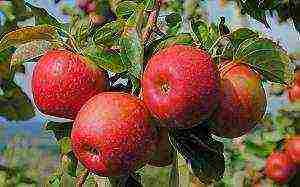Content [show]
Cabbage has many varieties, I will try to describe the best varieties of cabbage with photos and descriptions to help you with a difficult choice. Today in the article you will see:
Early varieties of cabbage; Cabbage for pickling and pickling
Cabbage for storage - the best decaying varieties of cabbage; Late cabbage - the best varieties
White cabbage varieties with photos and descriptions - the most productive varieties
Early varieties of cabbage
I really love cabbage salads, early varieties are best for this. They quickly form heads of cabbage, tender and juicy. An early variety of cabbage is always present in my garden, a little - 10-15 roots. In a summer borschik, a salad with apples leaves before the mid-season varieties ripen.
Although early cabbage usually has medium-sized heads of cabbage, it pays off with its rapid growth. Also, early varieties put up with cramped and poor soils, unlike their later counterparts.
Rinda F1
Heads of cabbage are formed 76 days after full germination. This variety is not only suitable for fresh consumption, but can also be stored for up to four months in a cool place. Excellent head of cabbage, not loose, but not too tight - good pleasant taste, no bitterness.
It grows well in different conditions - the yield depends on the place. The main thing is not to compact the crops too much. Can be re-grown by summer sowing.
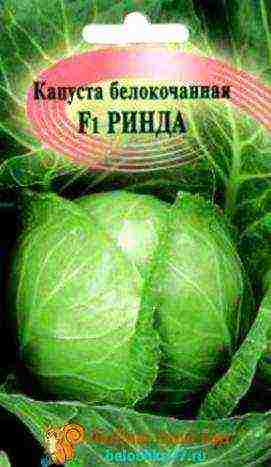 Rinda cabbage
Rinda cabbage
Cossack F1
A very early hybrid - ambassadors of planting seedlings, heads of cabbage ripen in 40 days. And if you sow seeds, then the harvest is ready after 60-70 days. The cabbage is beautiful - light green in color, inside the head of cabbage is yellow-cream. Heads of cabbage are small in size, medium density - weighing about 1.5 kg, without bitterness. Grows well under temporary shelter and in beds. Not damaged by flea beetles and rot.
This hybrid ripens 90-115 days after germination. Heads of cabbage of medium density, small - up to 1300g in weight. Stable, productive variety - ripening amicably, heads of cabbage do not crack, they have an excellent presentation. Calmly tolerates cold, does not get sick. It gives high yields on fertile soils.
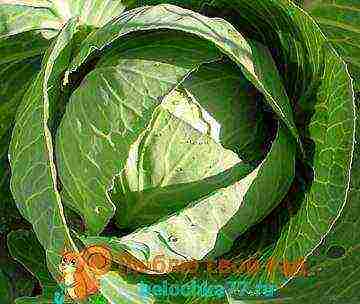 Variety Kazachok
Variety Kazachok
June
A popular, common early variety of cabbage. The crop can be harvested 2 months after transplanting. Heads of cabbage are light green, dense, can be planted often. In spring, it can easily withstand short-term frosts.
If you do not leave on horseback for a long time, then the heads of cabbage do not crack, do not bloom. Head of cabbage weight up to 2.5 kg.Good, delicate taste.
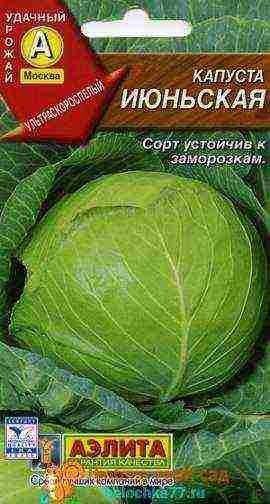 June cabbage variety
June cabbage variety
Dumas F1
Ripe heads of cabbage can be harvested 90 days after the first shoots appear. Heads of cabbage are dense, rounded, green outside - straw-colored inside with delicate tasty leaves. Weight is usually up to 1.4 kg. Does not burst and retains well during outgrowth. Pleases with stable, high yields, feels fine in thickened plantings.
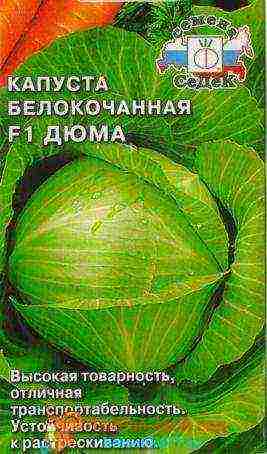 Dumas variety
Dumas variety
Tobia F1
Large hybrid with heads of cabbage up to 6 kg. Rich green upper leaves and light yellow inside, small stump. When overgrown, it does not crack and does not lose taste. Very high taste of the head of cabbage. Can be stored for a short time, resistant to diseases.
 Tobia variety
Tobia variety
Cabbage for pickling and pickling varieties - how to choose the best variety
Usually, mid-season and mid-late varieties are taken for salting. Mid-season varieties are also suitable for summer cooking.
Favorite and time-tested cabbage Slava.
It was also raised by my grandmother. Now there are a lot of new varieties and hybrids, but Slava keeps the brand and is still often found in the country and in the garden.
Mid-season and mid-late varieties of cabbage
Glory 1305
A well-known popular variety that ripens 115-120 days after germination. Good fresh and for pickling. Sauerkraut turns out to be of excellent taste. Round-flattened head of cabbage weighing up to 5 kg. With light green top leaves and white inside.
Grows well in cool, wet summers. It is well stored in winter and transported. Medium disease resistance.
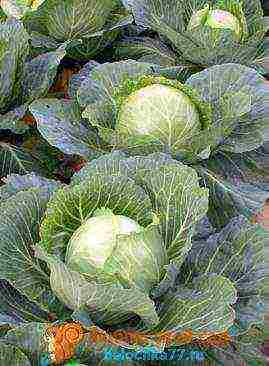 Slava grade
Slava grade
Atria F1
A mature variety, ripening on day 137-147 after full germination. Leaves are dark green with a strong waxy bloom. The stump is small inside, the heads of cabbage are dense, weighing up to 3.5 kg. High yielding variety, excellent taste, crack and disease resistant.
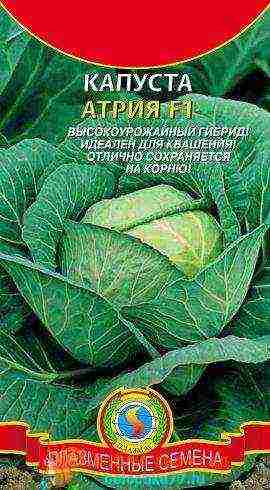 Variety Atria
Variety Atria
Dobrovodskaya
Medium late variety ideal for fermentation. Medium-dense rounded heads of cabbage weighing up to nine kilograms. The leaves are juicy, sweet, white and creamy. The variety is resistant to many diseases of cabbage and flea beetles. Stored up to five months after harvest.
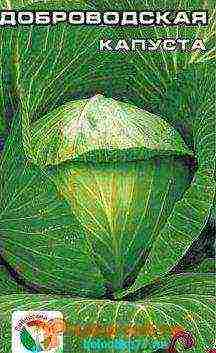 Dobrovodskaya cabbage
Dobrovodskaya cabbage
Present
Medium late variety, ripening 120-135 days after sowing. Perfect for pickling - the cabbage turns out to be juicy, tasty, spicy. Heads of cabbage are flattened about 4 kg in weight, the upper leaves are green with a waxy coating. The inner ones are white or light green.
Heads of cabbage do not crack when overgrown, they are resistant to rot and disease. It lies well in winter and tolerates transportation.
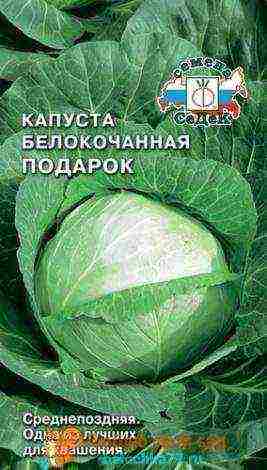 Cabbage variety Gift
Cabbage variety Gift
Midor F1
A mid-late ripening hybrid, the period before harvest is 140-160 days. Leaves are bright green with slight wrinkling with a noticeable waxy coating. The head is medium, round, dense with white leaves inside. The stump is small inside. Good taste. Good in vegetable salads and preparations for the winter.
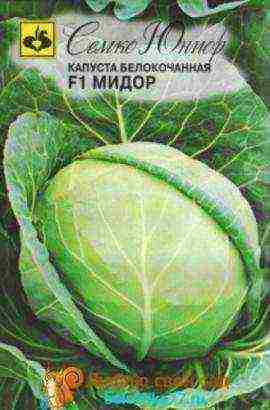 Variety Midor
Variety Midor
Krautman F1
Mid-season hybrid with very dense crispy leaves, very small stump. Weight up to 4.5 kg. With a long standing on the vine, even with a rainy summer, the heads of cabbage do not crack or rot. Stored after harvesting up to 4 months with preservation of excellent taste. Perfect for fermentation - the taste is pleasant. Not affected by diseases. The variety is keel resistant.
 Krautman variety
Krautman variety
Megaton F1
The most productive hybrid of the Dutch selection. From the emergence of the first shoots to harvest, 105 days pass. Heads of cabbage are round, up to 15 kg in weight, good taste. Cabbage is leveled in size and does not crack when excessive moisture is present. Suitable for fresh consumption and for processing. Great for fermentation.
Heads of cabbage are dense, convenient for transportation and sale, resistant to root rot and diseases. The variety is keel resistant.
 Megaton variety
Megaton variety
Merchant's wife
Medium late grade. Green on the outside in the cut is white. Heads of cabbage weight up to 2.8 kg. Good, great taste. Good in salting and fermentation. Resistant to diseases, can be stored for several months.
 Kupchikha variety
Kupchikha variety
Cabbage for storage - the best decaying varieties
Late ripening varieties are selected for storage.They develop for a long time, they have dense heads of cabbage, and are often stored until the next harvest. Late varieties are not afraid of spring and autumn frosts. Suitable for storage and salting, but cabbage turns out to be rougher, not as juicy and tasty as from earlier ripening varieties.
The best varieties of late cabbage
Aggressor F1
This is one of the best late varieties. In all regions, it shows a high yield, it can be stored for up to six months. The head of cabbage is round-flat, very dense, weighing up to 4.5 cm. It does not require careful maintenance; it grows well by itself. Yields in unfavorable conditions, resistant to cracking.
The Aggressor variety is tasty fresh and suitable for pickling and fermentation. Resistant to damage by cruciferous flea and fusarium disease.
 Variety Aggressor
Variety Aggressor
Mara
Late Belarusian variety. The period from germination to harvest is 155-167 days. Round heads of cabbage of dark green color with a strong waxy coating. Weighing up to 4 kg. Resistant to cracking. Very dense heads of cabbage, well kept. It tastes good when fresh, but excellent in sauerkraut. Stored in the cellar until April. The variety is resistant to root rot.
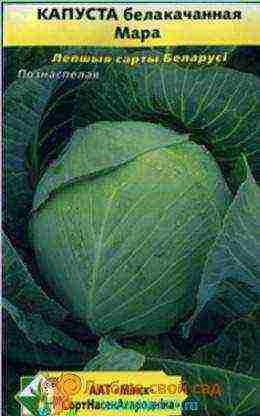 Mara variety
Mara variety
Amager 611
A well-known late variety, it takes 150-160 days before harvesting. The leaves are gray-green in color with a bright waxy bloom. Flat dense heads of cabbage greenish-white inside weighing up to five kg. A productive variety, ripens amicably. Heads of cabbage do not crack, they are resistant to decay.
It tolerates transportation well and can be stored for a long time up to six months. It tolerates spring cold well, but does not like drought.
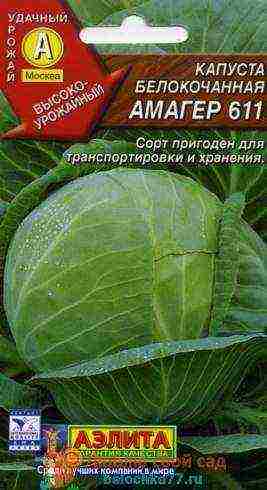 Amager variety
Amager variety
Snow White
Late variety (145-160 days). The head of cabbage is dense, flat-round, weighing up to 4 kg with good care. Inside, the leaves are juicy white with good taste without bitterness. This variety can be used to prepare baby food. The harvested crop is stored for up to 7 months and does not rot. Delicious when fermented. Resistant to diseases and pests, it tolerates transportation well.
Snow White variety
Valentine F1
Late ripe, suitable for long-term storage and fresh preparation. The head of cabbage is medium up to 3.8 kg, very dense, outside the leaves are green with a bloom, white on the cut. The stump is small. Excellent taste, fruitful hybrid.
 Variety Valentine
Variety Valentine
Gingerbread man F1
Late hybrid ripening 150 days after sowing. Differs in high taste, leaves are juicy, white without bitterness. Heads of cabbage weighing up to 5 kg. round, dense, suitable for salting, fermentation, fresh consumption. The stump is short. Cabbage Kolobok is well stored practically until April. The hybrid is resistant to many diseases, so you can get large yields with it without the use of chemicals.
 Kolobok variety
Kolobok variety
Many cabbage varieties were left without attention, but the most popular and productive cabbage varieties with photos and descriptions are shown in this article.
Best regards, Sophia Guseva.
How to grow cabbage
The cultivation of mid-and late-ripening white cabbage has its own characteristics.
First, the soil is cultivated in spring when it reaches normal ripeness in your garden plot and you can dig (plow) to the full depth of the shovel. Secondly, you can start making ridges and ridges on excessively moist soils.
Usually, the width of the surface of the ridges when growing white cabbage should be in the range of 100-120 cm, the height is 18-25 cm or more, depending on the degree of soil moisture. When making ridges, the soil should not be strongly compacted along the sides, so that there is no excessive loss of moisture for evaporation.
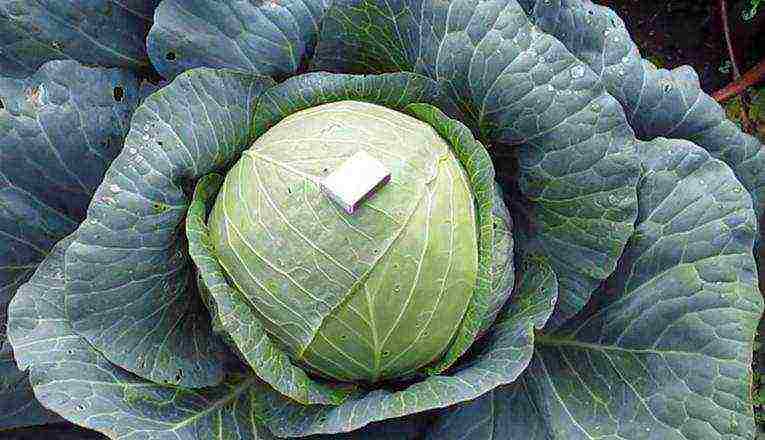
Photo of mid-season cabbage varieties Megaton
They fill the soil with organic fertilizers, if they were not applied in the fall or during the spring digging. It is advisable at this time to apply mineral fertilizers: ammonium nitrate or urea, superphosphate, potassium salt. It is better to apply organic fertilizers when planting seedlings in a hole (500 grams of humus each).
After digging, the soil is leveled with a rake and rows are marked. For growing cabbage of a medium or late ripening variety, row spacings of 60-70 cm are made.The distance in a row for medium varieties is 40-50 cm, for late white cabbage - 50-70 cm.
Planting technique is the same as for early maturing cabbage.
After planting, the soil must be regularly loosened, the plants must be hilled two or three times, watered, fed, weeded, and pests and diseases must be fought.
The first loosening of the row spacings is carried out on the day of planting of mid-season or late white cabbage, the subsequent ones - as needed, but preferably after each rain or watering. The depth of loosening should increase as the plants grow: the first loosening - by 5-8 cm, then up to 12 cm.
The first hilling of the cultivated white cabbage is carried out approximately 20-25 days after planting. On waterlogged soils, it is necessary to huddle in two directions.
Hilling is especially effective both in combating weeds in rows and for the formation of additional roots on the stump (stem). When hilling, loose soil is poured under the rosette of leaves, which suppresses the growth of weeds and promotes the awakening of the roots, which increase the nutrition and supply of plants with moisture. Before. the closing of leaves in rows is carried out up to 2-3 hilling.
It is necessary to constantly monitor the state of soil moisture.
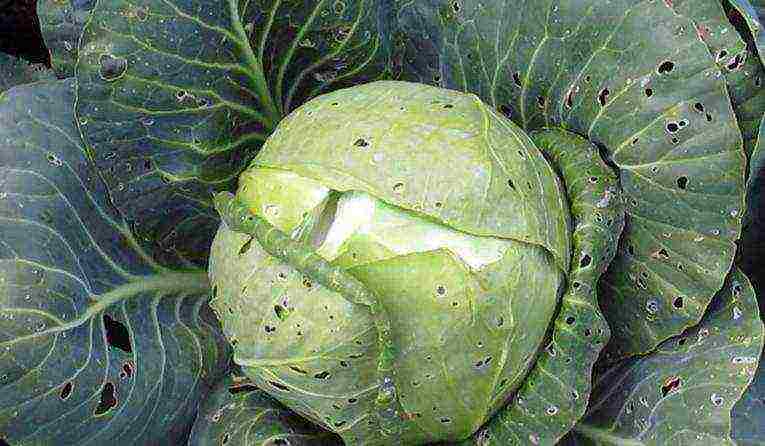
In the photo there is a mid-ripening cabbage variety Rinda
Leaves should not be allowed to wither due to lack of moisture. Watering time is determined as follows. They take a handful of earth in the upper soil layer at a depth of 20-25 cm, squeeze it tightly in the palm of your hand and throw a lump on a dense path from a height of 90-100 cm.
Another way: if the soil taken from a depth of 20 cm does not roll into a ball or forms into a fragile ball that disintegrates when pressed, then watering is required.
Usually, in the central regions, late white cabbage (as well as mid-season) cabbage is watered 3-4 times, in the north-western regions - 1-4 times, depending on growing conditions.
After each watering, the soil must be loosened to destroy the soil crust and preserve moisture.
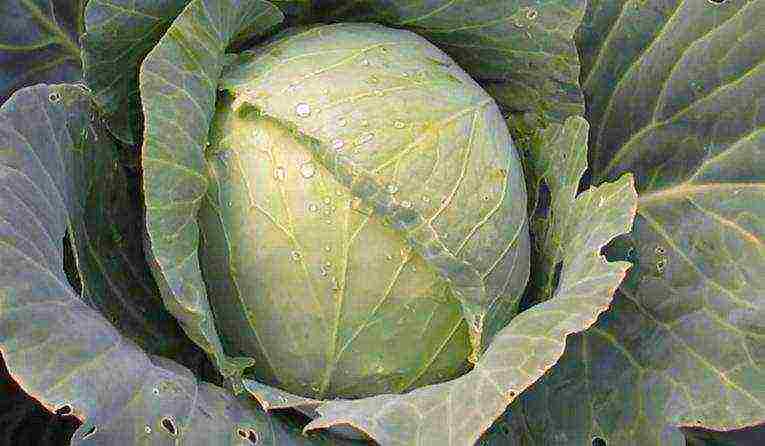
In the photo there is a mid-ripening white cabbage variety Hope
Mid-ripening and late-ripening cabbage varieties are distinguished by an increased requirement for nitrogen and potassium during their cultivation.
The first feeding is carried out during the period of increased leaf growth and the beginning of the formation of the rosette. Introduce 15-25 g / m² of active substance nitrogen, 15-20 g / m² of phosphorus and 15-25 g / m² of potassium on the 15-20th day after transplanting. Fertilizers are embedded to a depth of 8-10 cm within a radius of 8-10 cm from the plant.
The second feeding is carried out at the beginning of the formation of heads of cabbage in the middle of the row spacing, to a depth of 10-15 cm with the introduction of 20-30 g / m² of nitrogen, 20-25 g / m² of phosphorus and 20-30 g / m² of potassium.
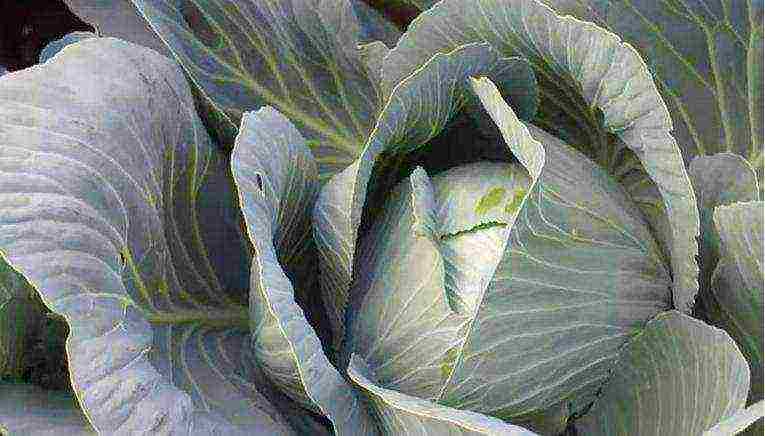
Photo of cabbage of medium late ripening variety Fundaxi
Liquid dressing is usually carried out in dry weather. In 10 liters of water, 20-25 g of ammonium nitrate, 30-40 g of superphosphate, 20-25 g of potassium chloride are dissolved. One watering can (10 liters) watered 18-20 plants.
Organic feeding of late and mid-season cabbage is given with a solution of mullein (1 part per 7 parts of water) or bird droppings (1: 15) per 10 liters of solution, add a glass of ash.
When growing white cabbage, dry fertilizers are applied when the soil is wet, scattering them along the aisle, and then immediately embedded in the soil with a hoe during loosening or hilling.
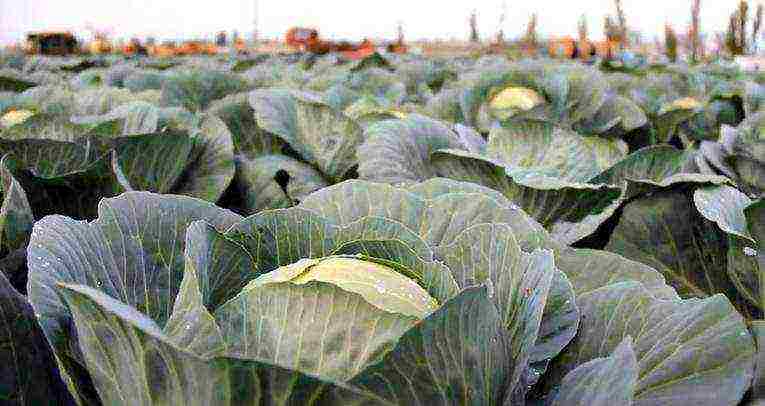
In the photo, a hybrid form of late white cabbage Centurion F 1
Cabbage has a lot of pests. From the very first day of planting, you must carefully monitor their appearance, daily examining the leaves of the plants. Already with a single appearance of pests on the heads of mid-season and late cabbage, it is necessary to immediately take measures to destroy them.
Medium late varieties and hybrids of white cabbage
Variety Brigadier F1 Is a light green hybrid of medium late white cabbage of the summer-autumn cultivation cycle, which is suitable for processing and further storage for up to 5 months. Quality heads of cabbage with a snow-white, dense inner structure, good for fermentation.Also grown for sale - on the fresh market - when the end consumer needs larger heads. White cabbage of this variety ripens in 110-120 days. When grown, the number of plants per 1 hectare is about 35,000. The weight of a head of cabbage Brigadier F1 is from 3 to 4 and a half kilograms, and with more rarefied crops - four to six kg. High content of vitamin "C", cabbage variety Brigadier F1 tolerates low temperatures, good standing in the field is noted for up to 42 days.

Photo hybrid of cabbage Brigadier F1
Another medium-late hybrid with high yields is Krautman F1. It is able to maintain its presentation in the field (gray-green heads of cabbage weighing 2-5 kilos) for a long time without cracking the head. The mid-ripening Krautman F1 cabbage combines the ability to preserve up to 4 months and excellent pickling qualities for cabbage. For industrial cultivation of the Krautman F1 cabbage hybrid, we recommend setting a planting density of up to 42,000 cabbage plants of this variety per hectare.
Video about one of the best cabbage hybrids Megaton F1:
Present - a productive variety of mid-ripening white cabbage (ripening period 115-135 days). Heads of cabbage are dense, rounded, stored for 6 months. The average weight of one head of cabbage of the Podarok variety is 3.0-3.5 kg. Marketability is approaching 100%. Used fresh and for processing.
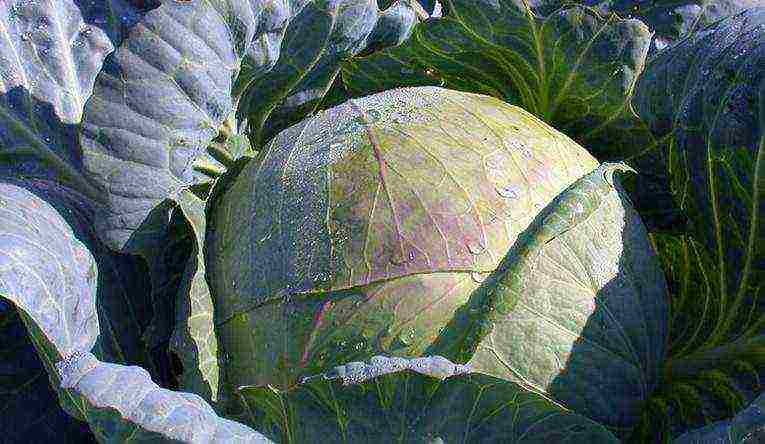
Photo of a head of mid-ripening white cabbage of the Podarok variety
Kashirka 202 - one of the best pickling varieties of white cabbage. Heads of cabbage are dense, large, rounded, on a high cabbage stump. The mass of a head of cabbage variety Kashirka 202 is up to 8 kg. Demanding on moisture and soil.
Likurishka 498/15 - heat-resistant mid-season variety. Cabbage heads up to 2-3 kg, dense, round-flat or rounded with a slope upward. Taste qualities of cabbage variety Likurishka 498/15 are good, suitable for pickling.
|
Read an article on the different types of cabbage |
Winter mushroom - cabbage heads are round (photo below), dense, weighing up to three kilograms, are distinguished by good transportability. Cabbage variety Winter Gribovskaya is used for winter storage, pickling. Moisture-loving.
Winter mushroom 13 - hygrophilous, resistant to keel. For the rest of the characteristics and for the purpose it is close to the variety Zimnyaya Gribovskaya.
Ladozhskaya 22 - a productive variety. This cabbage is distinguished by its high resistance to keel. Heads of cabbage are dense, round, of medium size. Used for fermentation, heads of white cabbage of the Ladozhskaya 22 variety are perfectly stored fresh until February.
Yielding - a high-yielding, kilo-resistant variety. The heads of cabbage are juicy and resistant to cracking. Used white cabbage of the Urozhaynaya variety for pickling, and also suitable for long-term storage.
Late-ripening cabbage varieties
Amager 611 - this variety of late-ripening cabbage (from planting cabbage seedlings to harvest takes 118-149 days) is used for long-term winter storage (until April). His heads of cabbage are medium-sized, very dense, weighing 2-4 kg, heads of cabbage are flat-round in shape, the stump is small. When growing cabbage variety Amager 611, the yield can be more than 6 kg per square meter. Valuable for long distance transportation.
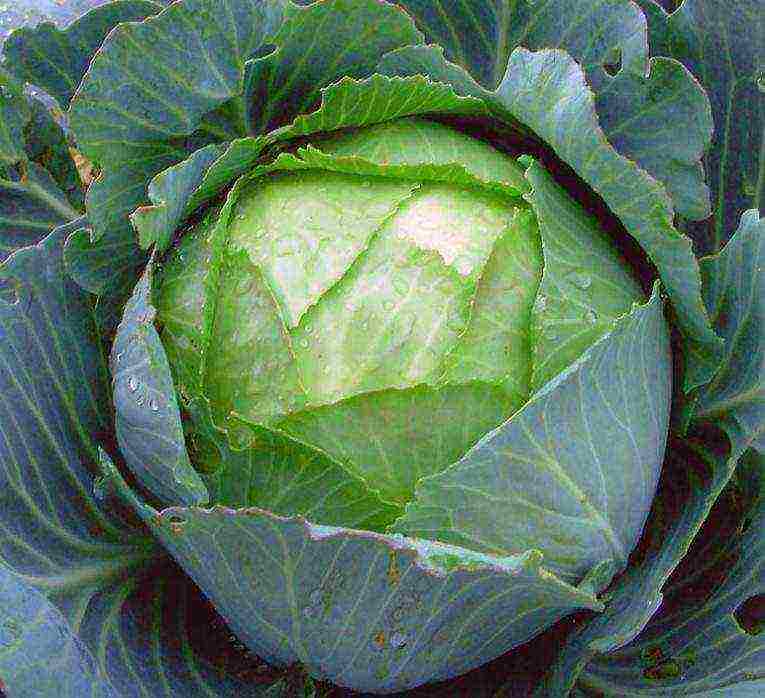
In the photo, the variety of cabbage Amager 611
Moscow late 15 - round and dense heads of cabbage of this late ripening cabbage are large, reaching a mass of 3-5 kg. Cabbage variety Moskovskaya Late 15 is demanding on moisture and soil fertility. Has relative resistance to keel. Not good for storage, but great for pickling.
Wintering 1474 - late cabbage (130-150 days), stored until the new harvest (has a marketability of up to 90% by 6 months). And over time, the taste of Zimovka only improves. An unsurpassed variety for the tenderness of the heads of cabbage (dense, round, weighing 2-3 kg).

In the photo Wintering 1474
Variety Moscow late 9 - white cabbage, which, when grown on seasoned soils, gives a higher yield than Moscow late 15. The varieties are similar in use and morphology.
Mushroom hybrid 1- a universal variety for the use of the crop. Dense heads of cabbage, round-flat, good taste, well stored in winter.
Rusinovka - vegetation period is 135-160 days; when grown, late-ripening white cabbage reaches a mass of 3 kg or even more. Rusinovka is suitable for fermentation, keel resistant.
Video about an excellent variety of white cabbage for pickling and storage - a hybrid Centurion F1:
White cabbage is an incredibly healthy vegetable with a rich vitamin and mineral composition. This explains its popularity among gardeners. The cultivation rules are not complicated, but the basis for the yield depends on the choice of the variety.
Varietal variety of white cabbage
In the old days, there was really a shortage of seed material due to limited supplies from the near and far abroad, therefore, the seeds were often harvested from the usual varieties.
For more than 20 years, the situation has radically changed, and the varietal assortment of many gardeners continues to consist of 2-3 items. And in vain, because new developments have no less valuable qualities, which consist in resistance of cabbage to diseases and pests.
This is especially important when you consider that the moisture-loving plant literally attracts insects and fungi.
This article discusses early, mid-season and late-ripening varieties of a popular vegetable with a description that will expand the variety of crops grown in your garden and in the Urals and in the middle lane.
Most Popular
The variety of cabbage is selected not only taking into account the winter and climatic characteristics of the region, but also by appointment... The mineral and vitamin composition of each plant is different, but it is also influenced by the conditions of agricultural technology and the type of soil.
In order to choose the appropriate option it was easier, the varietal assortment is divided into groups, united by a common feature.
The best late varieties of cabbage for long-term storage
Aggressor Is a mid-late hybrid developed by breeders from Holland. Differs in minimal care and resistance to fusarium, thrips damage.
Vegetation lasts up to 120 days, you can sow seeds directly on an open bed. A ripe vegetable weighs 3-5 kg. Shelf life and processing - up to 5 months.
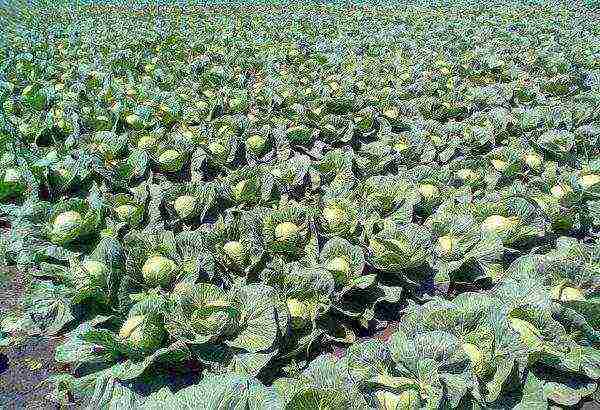 Aggressor
Aggressor
Amager - late cabbage with a ripening period 120-147 days... The heads are round-flat green, sometimes with a bluish tinge, weight about 3-4 kg.
When planting, the scheme is used: 3-4 plants per 1 m2. For six months, the nutritional value and presentation are preserved. Weather cataclysms and violation of the watering regime do not violate the density of the structure and the integrity of the head.
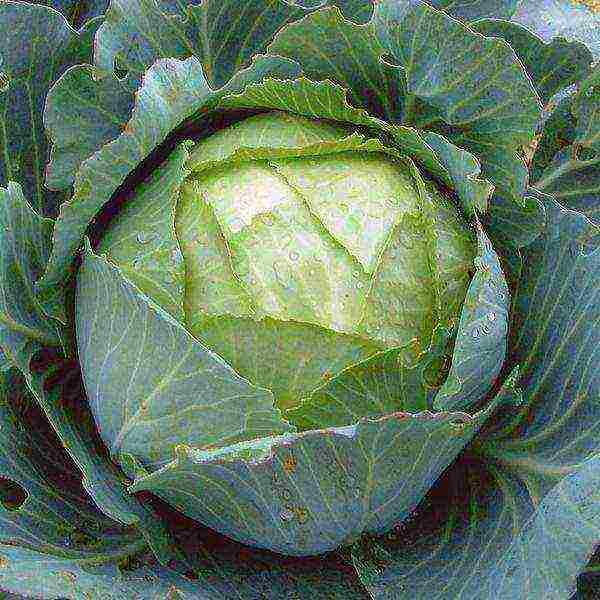 Amager
Amager
Valentine - growing season 155-180 days after transferring seedlings to open beds. The gray-green heads have a slight waxy coating, the weight tightens up to 4 kg.
Cabbage retains its taste and presentation until the beginning of the next season (June). The hybrid is tolerant to fusarium, gray rot. The head of cabbage does not crack due to violations of the moisture regime.
When planting, the scheme is used: 2-4 plants per 1 m2.
 Valentine
Valentine
Gingerbread man - hybrid forms heads later 115-125 days after planting seedlings. Round fruits have a dense structure, the average weight is 2-3 kg. Planting scheme: 3-4 plants per 1 m2.
Due to its good immunity, it exhibits tolerance to punctate necrosis and thrips. For 8-10 months, cabbage retains its nutritional value and presentation.
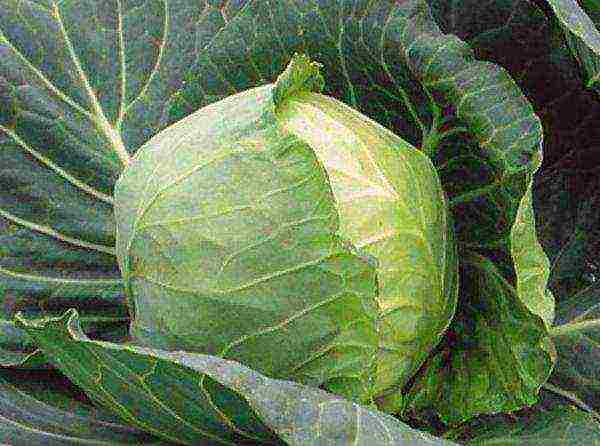 Gingerbread man
Gingerbread man
Mara - very dense heads are not susceptible to cracking, the average weight is 3 kg. The variety is distinguished by good taste, transportability and long shelf life (more than 7 months).
The main advantage is resistance to the accumulation of nitrates and radionuclides. Vegetables are harvested through 160-175 days after transplanting seedlings.
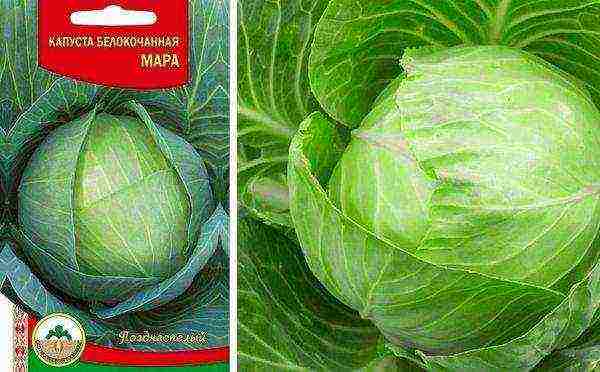 Mara
Mara
Moscow - a variety developed by domestic breeders, who took into account the climatic features and possible problems with pests when growing.
Harvesting begins later 130-140 days after disembarking seedlings. Gray-green rounded heads of cabbage weigh 4-7 kg on average. When planting, the scheme is used: 2-3 plants per 1 m2.
Cabbage is resistant to cracking, has a delicate juicy pulp. Without loss of taste and presentation, the vegetable is stored for 6-8 months.
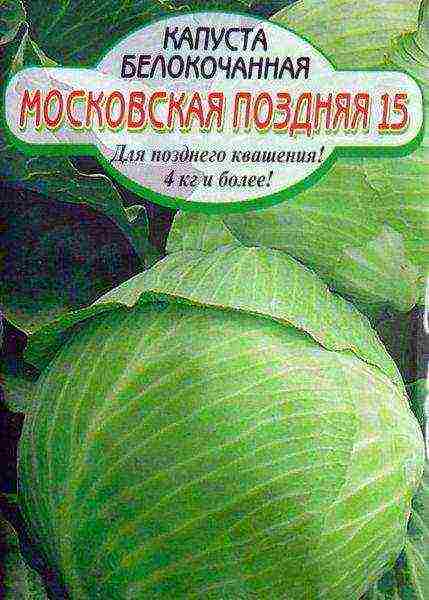 Moscow
Moscow
Mid-season white cabbage
Megaton - the hybrid matures in 102 days after planting seedlings. The great need for moisture and fertilizers strengthens the immune system, which resists many diseases and insect infestations.
The round-flattened gray-green head weighs up to 15 kg. The location of the holes when planting: 3 plants per 1 m2. Duration of storage without loss of nutritional qualities and presentable appearance is 4-6 months.
Merchant's wife - a disease-resistant high-yielding variety, distinguished by simple agricultural technology. About 500 centners are removed from a hectare (head weight up to 3 kg). When planting, the scheme is used: 3-4 plants per 1 m2.
Harvesting begins later 130-150 days after transferring seedlings to the beds.
 Merchant's wife
Merchant's wife
Atria - the fruit of the works of Dutch breeders with the growing season 110-120 days... The head of cabbage has a round-flat head of blue-green color, the average weight of which reaches 5-7 kg. Often there are specimens of 8-8.5 kg. When planting, the scheme is used: 3 plants per 1 m2.
Thanks to its good immunity, it resists pests (in particular thrips) and fusarium. The commercial and taste qualities are preserved for 4-6 months.
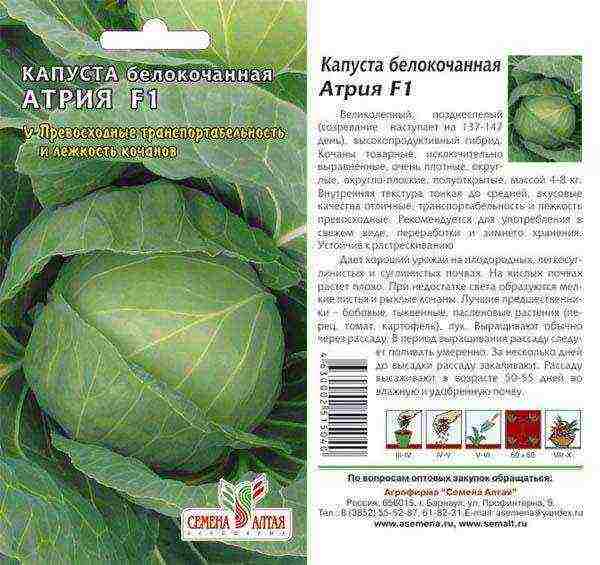 Atria
Atria
Glory - the fruit of the work of Russian breeders, the growing season is 120-130 day after planting seedlings.
Round heads have a light green color with a grayish tinge, the weight tightens up to 3-5 kg. When planting, the holes are arranged according to the scheme: 3-4 plants per 1 m2.
The advantage of the variety is its taste, the disadvantage is short storage (about 2 months). Glory is one of the best pickling options.
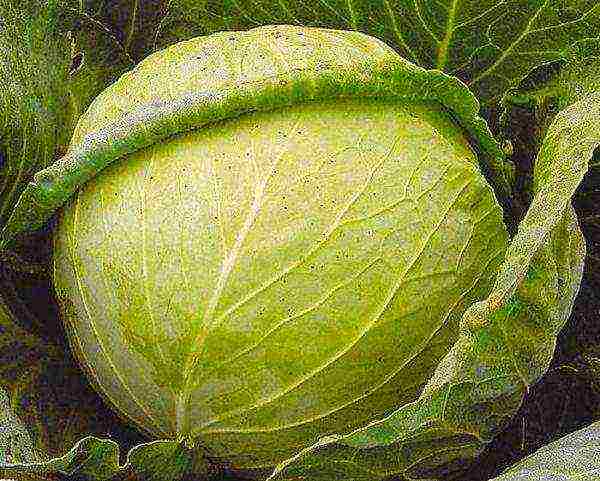 Glory
Glory
Sugar queen - the hybrid ripens after planting seedlings through 120-140 days... Dense rounded heads have a slightly greenish tint, weighing up to 4 kg.
When planting, the scheme is used: 3 plants per 1 m2. A universal variety, used fresh and for salting. The shelf life without loss of valuable qualities is 3-4 months.
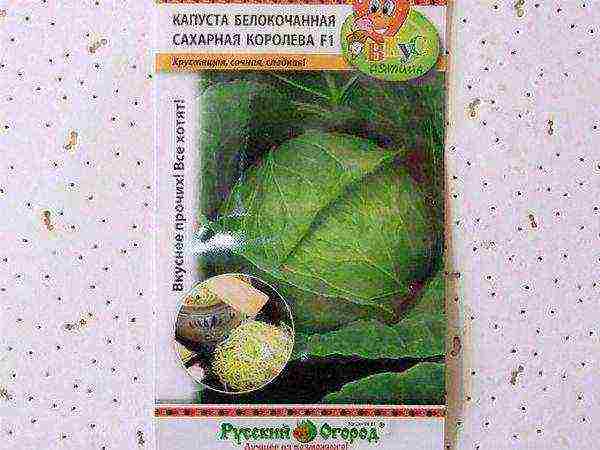 Sugar queen
Sugar queen
Early ripe
Rinda - the ripening period of the hybrid is 75-80 days after disembarking seedlings. Round heads weighing up to 7 kg have a green color and a dense structure. Hole layout: plant 3-5 plants per 1 m2. Differs in unpretentiousness to weather conditions.
The shelf life without loss of taste and presentation does not exceed 4 months.
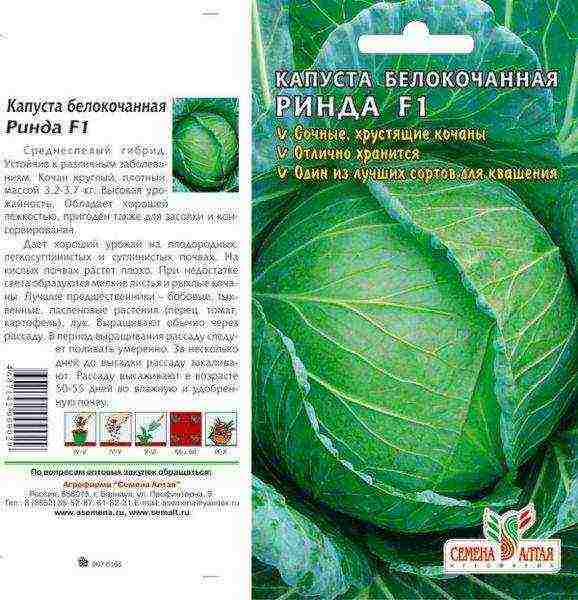 Rinda
Rinda
Kazachok - an early hybrid is distinguished by early maturity, you can harvest through 45-55 days after disembarking seedlings. The weight of the medium-sized light green head is 1.5 kg.
The scheme used for planting: 5-6 plants per 1 m2. Recommended for cultivation under any kind of film and in the open field. Cabbage resists the causative agents of mucous bacteriosis and black leg.
 Kazachok
Kazachok
June - the variety is ready for planting in open ground already at the beginning of May, after 45-50 days you can harvest. The structure of the head is of medium density, the weight reaches 1.4-1.7 kg. When grown on highly fertile soils, the weight of a head of cabbage reaches 5 kg.
The layout of the holes when planting: 3-5 plants per 1 m2. Cabbage is distinguished by the amicability of the emergence of seedlings and excellent taste.
 June
June
Tobia Is a Dutch hybrid characterized by resistance to fusarium wilt. The layout of the holes when planting: 2-3 plants per 1 m2. Round-flat heads of dark green color reach a weight of up to 7 kg. Fruit ripening occurs later 85-90 days after disembarking seedlings.
It has a strong root system, if the irrigation regime is violated, the head of cabbage does not crack. It retains its taste and marketability for 5-6 months.
 Tobia
Tobia
Varietal variety will ensure yields even in difficult weather conditions, because each plant has its own immunity to diseases and pests. The taste qualities of the varieties stimulate new experiments, which continue already in the kitchen.
“Beet varieties are some of the best among these vegetables.
Wood ash as fertilizer - help in the garden, flowers and in the garden "
The best varieties of cabbage for regions with descriptions and photos - early, middle and late
What varieties of cabbage are best grown in different regions of Russia
Different regions of Russia have their own best varieties of white cabbage (the article will contain their description and photos). She is one of the most demanded vegetables, along with beets, potatoes and carrots, on the table among the peoples of many countries of the world. You can talk for a very long time about its benefits, taste and healing qualities. Talking about which variety is better is useless, because everyone has their own taste. Some people like tender cabbage of early varieties, others like sauerkraut, and still others prefer heads of cabbage intended for storage.
So how can a gardener begin to grow cabbage to decide on the choice of a variety? First, you need to determine which cabbage ripening period is needed and in what quality it will be used. Secondly, on the basis of her choice in terms of ripening, consult with neighbors in the summer cottage, find out from them what they are growing and what results they are achieving. Thirdly, find more detailed information in the press or on the Internet about the selected varieties or hybrids of vegetables.
Many are convinced that 5 - 6 varieties should be grown in order to obtain a uniform harvest according to the season and its rational use in winter. Two early, ripening at different times, one mid-season for fermentation and two - three late for late fermentation and laying in a cellar for winter storage.
For the middle lane
The middle zone of Russia is the most favorable for the cultivation of cabbage, therefore, most of all its varieties are zoned here, some of which are widespread in adjacent regions. Conditions for the growing season of these vegetables are similar to this region - in the Far East, South Urals and the south of Western Siberia... Therefore, most of the best varieties of our vegetables from central Russia are grown in these regions as well.
Early cabbage types for this region
Early cabbage is planted for summer consumption. She goes to salads, cabbage soup, borscht, and other soups. It is also suitable for extinguishing. The main criteria for choosing the best examples of these vegetables: the taste and juiciness of the heads of cabbage, how they are prone to cracking, whether they can prematurely release a flower arrow. Early cabbage can be eaten a couple of months after planting in a greenhouse, protected or open ground, so all varieties of it are grown in any climatic zone, with some exceptions. The best early vegetables are both mouth-watering leaves and heads of cabbage after a short period of time. They can endure chilly springs, matinees and close landing on the site. Such varieties, which are lighter than others, withstand a lack of fertilizer in the soil. But if the volume of collection is the main thing, then you have to worry about feeding the cabbage.
June
One of the most popular in our country. It is so named because its first crop is harvested at the end of June. The taste is very high. The disadvantage is that the harvest of vegetables ripens at the same time, you have to harvest in one or two steps. In the future, the heads of cabbage crack and lose marketability. Seedlings are planted with the "June" very first garden crop, as it can tolerate spring five-degree (with a minus sign) matinees. Weight 1.2 - 2.2, yield - 3.9 - 6.1.
! Note: Hereinafter, the weight is indicated in kilograms, the yield in kilograms per 1 sq. m!
Kazachok
Heads of cabbage, used mainly fresh, ripen in the same period as June. The variety does not crack or get sick, due to the rise of small round heads of cabbage above the soil surface. The same quality allows for mechanized harvesting.Average weight - 1.05, yield - 4.8 - 7.2.
Transfer F1
Cabbage, which needs 85 - 117 days from the appearance of cotyledon leaves to a not very large fork. Its outer leaves are of a pleasant pale emerald hue, inside are almost milky. The mass of a vegetable is no more than one and a half kilograms (usually, about 1). The taste is delicious. Stable collection, with a large yield of tight heads, maturing amicably at the earliest possible date. Heads of cabbage do not burst. The variety is weakly susceptible to disease and perfectly withstands cold spring. With a fairly high level of fertility, it yields a crop of up to 7.5 kg.
Number One Gribovsky 147
It sings 8 - 16 days later than June. Thanks to this, they can be grown in the garden to extend their consumption. The forks of "Gribovskaya" are mostly rounded, less often oval. They are well adapted to cold snaps and drying out of soil moisture. Average weight - 1.1 - 1.8, yield - 3.1 - 5.8.
Dot
Very early cabbage. The first use of loose heads of cabbage begins after a month and a half of the growing season. Medium-density cone forks. The leaf coverts of vegetables are light green. The cut cabbage is whitish-yellow in color. Average weight - 0.9 - 1.5, yield - 3.1 - 6.4.
Stakhanovka 1513
Ripening occurs a little later than the varieties described above, due to this, the weight of the forks and the yield increase. Stakhanovka is eaten fresh and fermented successfully. It has round medium density forks. Average weight - 1.7 - 3.2, yield - 4.8 - 7.2.
Malachite F1
It only takes two months from seedling to harvest. Very rounded, weighing 1.2 - 1.4, stuffed, does not burst. It stands out for its remarkable raw food flavoring qualities. It matures at once, harvested in 7 - 13 days. Harvest 3.8 - 6.3.
Types of mid-season cabbage
This cabbage pleases gardeners in the middle and late summer. Its heads are more juicy, contain a lot of sugars, they absorb a large amount of moisture and, as a result, are very responsive to watering. Mid-season products are ready for selective harvesting when the early varieties of vegetables are already leaving. They eat it fresh, but more often they ferment it.
Belarusian 455
A popular old variety, long zoned, its juicy heads of cabbage ripen in three months or so. "Belorusskaya" is perfect for sourdough, both cut into quarters with forks, and finely chopped. Average weight - 1.5 - 3.9, yield - 5.1 - 7.3.
Sibiryachka 60
"Sibiryachka" sings faster than "Belorusskaya" for about a week. The forks are loose, so they hardly crack, they are cold-resistant enough. Sibiryachka is used in fresh autumn and winter. And it is good for fermentation. Average weight - 2.6 - 4.0, yield - 4.9 - 7.5.
Golden hectare 1432
It ripens four months after mass shoots. The shape of the heads is almost a perfect ball, they taste good. Rich in vitamin "C", according to this indicator - the leader among representatives of cabbage. Vegetables have even, dense, leveled heads of cabbage. "Golden hectare" is resistant to cracking, forks do not last long, they are mainly fermented. Average weight - 1.9 - 3.0, yield - 5.6 - 7.9.
Glory 1305
In our opinion, Slava is the best in sourdough. It is very fruitful, with amicable response and early autumn ripening. The heads of cabbage are so dense that they are prone to cracking, so they need to be removed and fermented on time. "Glory" is stored only until the New Year. Average weight - 2.7 - 4.2, yield - 6.1 - 8.7.
Hope
The most productive of the mid-season. Ripens in late summer. Lies until February, then withers quickly. It ferments well, is very tasty when leavened and fresh. The head of cabbage at "Nadezhda" is round, dense, does not crack. The average weight of a vegetable is 3 - 3.5, yield - 7.5 - 11.9.
Present
"Gift" is very versatile, very tasty. Fresh salads, preparations for the winter, pickled forks - everything is at the highest level. Cabbage is stored until mid-winter. It has round and rather large heads of cabbage, growing on average for about four months. "Gift" is resistant to cracking.Weight (average) - 2.9 - 4.1, yield - 7.1 - 8.8.
Rinda F1
Mid-season cabbage hybrid. Head of cabbage is round. Rinda F1 is tasty raw and good for winter canning. Can be stored in cold rooms for up to three months. The inner texture of the fork (3.3 - 3.6) is excellent, loosely packed. Leaf without harsh bitterness and with a special aftertaste. The amount of the fee depends on the circumstances of the cultivation. It grows well both in spring planting and in summer sowing. Collection 8.7 - 9.2.
Semko Jubilee 217 F1
They are used in natural form, in pickles and for storage (up to six months). The maturity of the heads occurs at 125 - 136 days. The forks are stuffed or very tight. The weight of the head of Semko is from 3.8 to 4.1 kilograms. The palatability of raw and sauerkraut is excellent. Collection 7.6 - 8.5. Disease resistant.
From late-ripening (late) varieties of cabbage
Late cabbage is the leader in yield. It is not surprising, because such vegetables grow the longest, almost five months. This cabbage is richer than all the others in vitamins and sugars. Her heads of cabbage lie in good conditions until the next harvest. Another feature of the late varieties is an improvement in their taste during maturation, which is due to the transformation of sugars inside the head of cabbage.
Amager 611
An unpretentious popular variety of cabbage. Due to its bitterness, it is slightly affected by insects: caterpillars and aphids. During incubation, the bitterness disappears, the heads of cabbage gain juice, and their taste improves. Of the late ones, "Amager" ripens in the first place, and is stored until April. He does not tolerate heat well. Regular watering of vegetables and mulching the soil around them is mandatory, especially in dry summers. Average weight -2.8 - 3.4, yield - 3.8 - 6.3.
Kharkov winter
The dense heads of this old popular variety are flat and even flat-convex, do not crack and store very well. Harvested in October, they will last until spring under appropriate storage conditions. "Kharkiv winter" tolerates heat and cold well, heads of cabbage should be removed after they "have enough" frost. These vegetables are mainly eaten fresh, and they are also suitable for canning. Zoned only along the southern border of the middle zone. Average weight - 3.6 - 3.9, yield - 6.1 - 8.1.
Moscow late 15 (9)
The popular late cabbage is the leader in terms of its own weight of the head of cabbage. Cold-resistant, easily tolerates negative temperatures, both in spring and autumn. "Moscow late" is very responsive to watering and feeding, because it needs to gain a large mass and a huge amount of vitamins and sugars. This cabbage is stored very well and is one of the few late-ripening cabbage that can be fermented. Ripens "Moscow late" four and a half months after germination. Average weight - 3.6 - 4.2, yield - 6.8 - 8.1.
Wintering 1474
"Wintering" grows for a very long time. The growing season for vegetables is about six months. But it also lies, but all winter and spring, it is not without reason that it is so named. With long-term storage, it gives almost no waste, and the taste only improves. Very dense, medium-sized head of cabbage. Average weight - 2.2 - 3.4, yield - 4.6 - 5.1.
Midor
Medium late monohybrid with a period of 135 - 159 days before harvest. The leaves are bright green, the wrinkling is weak, the wax coating is excellent. Head of cabbage (2.7 - 3.8) simple, spherical and stuffed, the inner leaves are snow-white. A stump in the back is a short fork. The taste is delicious. You can make vegetable salads and ferment for the winter. Collection 5.7 - 7.2 kg.
For Moscow region
In the Moscow region, the following are zoned from the above:
- Early: "Number One Gribovsky", "Golden Hectar", "Stakhanovka".
- Mid-season: "Glory", "Belorusskaya", "Gift".
- Mid late: "Winter Gribovskaya".
- Late: "Moscow Late", "Amager".
For the Urals
The conditions of the Northern Urals for vegetables are similar to those of Eastern Siberia. Some of the varieties already mentioned are grown in these areas.
- Early: "June", "Number one Gribovsky", "Stakhanovka".
- Average: "Golden Hectare", "Glory", "Belorusskaya", "Gift".
- Late: "Winter Gribovskaya", "Amager".
And also zoned such as:
Early ripening
Bred from crossing various varieties of old German cabbage "Dietmarscher". Sung before the "Number of the first Gribovsky". The forks are aligned, presentation. It is similar to June, only loses in terms of yield. Zoned for the North-West region and Western Siberia in 1973. Average weight - 0.9 - 1.1, yield - 3.7 - 5.2.
Polar K - 206 (number one polar)
Early variety. Bred in 1950 by selection from samples of the "Number of the First Gribovsky". He is five to ten days later than his parent. But the weight of the heads of cabbage and the yield are noticeably higher, and, in contrast to "Gribovsky", can be used for fermentation. Ripening is not uniform, which makes it possible to extend the harvesting period of the product. Forks are not resistant to blooming and cracking. Average weight - 1.9 - 2.8, yield - 4.7 - 5.9.
For the south of Russia
These areas are characterized not only by a warmer climate, but also by shorter daylight hours. And therefore, the requirements for vegetables, and in particular for cabbage, are slightly different here.
From zoned in the central zone, they grow here:
- Early: "Number one Gribovsky."
- Mid-season: "Glory".
Mozharskaya local
Most likely, this is folk selection, since there is no documentary material about its origin. Medium late rounded flat cabbage, quite heat-resistant. It is well transported and lies. Suitable for leavening. Average weight - 2.7, yield - 4.9.
Judge 146
An old southern mid-late variety of cabbage. Tolerates elevated temperatures. Fresh and recycled are the best use cases. Average weight - 2.3, yield - 4.7.
In addition to the usual division of vegetables into early, medium and winter varieties, in the south of Russia they are zoned for autumn and sub-winter crops.
Zavadovskaya
For autumn sowing. Ripens five to six months after sowing. Heat-resistant, prefers fertile soil. Her forks are round, dense. "Zavadovskaya" is fermented and eaten fresh. Weight - 7.7, yield - 16.9.
Derbent local improved
"Derbentskaya" was bred specifically for the southern regions, sown before winter. After three months, it is ready for use. Medium cone forks. Average weight - 1.1 - 1.5, yield - 2.6 - 3.4.

